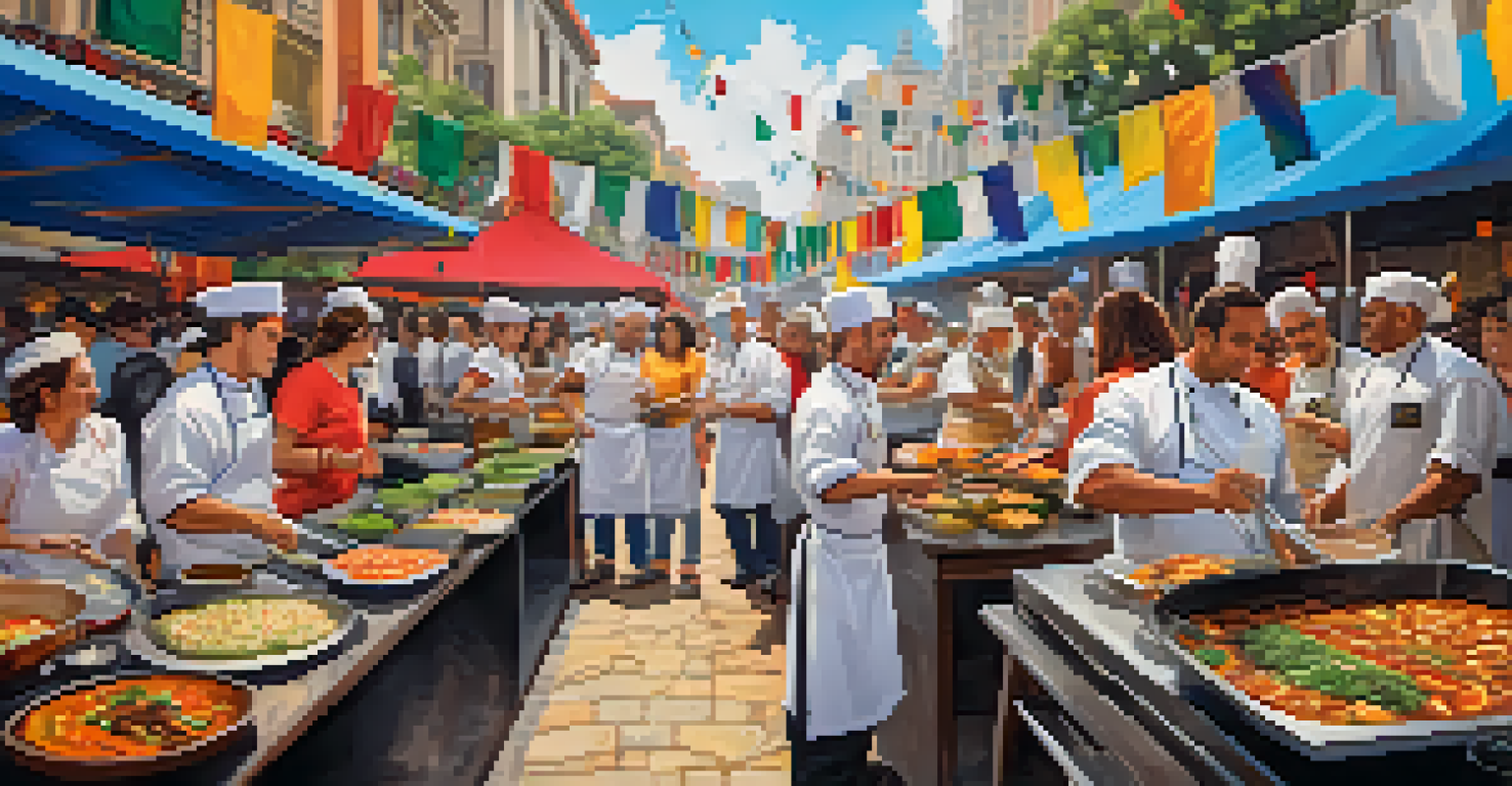The Culinary Heritage of São Paulo: A Taste of Diversity

The Melting Pot of Cultures in São Paulo's Cuisine
São Paulo is often described as a melting pot of cultures, and its cuisine reflects this vibrant mix. With influences from Italian, Japanese, African, and Middle Eastern communities, every meal tells a story of immigration and adaptation. You can taste this diversity in dishes like the beloved 'feijoada,' a black bean stew with roots in Portuguese and African traditions.
Food is our common ground, a universal experience.
As you stroll through the bustling streets, you'll encounter food stalls and restaurants that showcase this rich tapestry. The city's culinary scene is not just about food; it’s a celebration of heritage and identity. Each dish serves as a reminder of the diverse communities that have shaped São Paulo into the gastronomic powerhouse it is today.
This cultural fusion has also led to innovative culinary techniques and the creation of new dishes that honor traditional flavors while embracing modern trends. São Paulo's chefs and home cooks alike continue to push the boundaries of what Brazilian cuisine can be, inviting everyone to join in on the exploration.
Street Food: A Flavorful Adventure
Street food in São Paulo is not just a quick bite; it's an adventure filled with bold flavors and unique combinations. From the iconic 'pastel' – a deep-fried pastry often filled with cheese or meat – to 'cachorro-quente' (Brazilian hot dogs) loaded with toppings, there's something for everyone. These dishes are affordable and accessible, making them a staple for locals and tourists alike.

Walking through neighborhoods like Liberdade, the heart of the Japanese community, you can savor grilled skewers and mochi, reflecting the Asian influence on the city's cuisine. Similarly, the markets of the city offer an array of treats, where you can sample everything from traditional Brazilian sweets to savory snacks. It's a culinary journey that unfolds with every step.
Cultural Fusion in São Paulo's Cuisine
São Paulo's cuisine is a vibrant blend of influences from Italian, Japanese, African, and Middle Eastern cultures, creating a unique culinary landscape.
Moreover, street food stands often serve as gathering spots, fostering a sense of community among those who enjoy the flavors of São Paulo. Sharing a meal from a street vendor is an experience that transcends language barriers and brings people together over shared tastes and stories.
Influence of Italian Cuisine on São Paulo
Italian immigrants have left a significant mark on São Paulo's culinary landscape, especially with the introduction of pasta and pizza. You can find pizzerias that serve up delicious, thin-crust pies topped with a variety of ingredients, reflecting both tradition and local flair. The famous 'pizza paulista' is a testament to this Italian influence, often featuring unique toppings that cater to Brazilian tastes.
The discovery of a new dish does more for the happiness of mankind than the discovery of a star.
Beyond pizza, Italian dishes like 'lasagna' and 'risotto' have been embraced and adapted, creating a fusion that showcases São Paulo's versatility. Many restaurants in the city offer these dishes with a twist, incorporating local ingredients that add a distinct Brazilian flavor. It’s this innovation that keeps the dining scene exciting and ever-evolving.
The affection for Italian cuisine is also evident in the way families gather around the table to share meals, mirroring the Italian tradition of communal dining. This sense of togetherness is a cherished aspect of São Paulo's food culture, where every meal is an opportunity to connect and celebrate.
The Role of Japanese Cuisine in São Paulo
Japanese cuisine holds a special place in São Paulo's culinary heritage, thanks to a large Japanese immigrant community. Sushi, sashimi, and tempura are just a few examples of the delicious offerings that have become mainstays in the city. The blend of Japanese techniques with Brazilian ingredients has led to the creation of unique dishes that highlight this cultural fusion.
One notable example is 'temaki,' a hand-rolled sushi that reflects both Japanese tradition and Brazilian creativity, often filled with local fish and tropical fruits. The popularity of these dishes has contributed to the rise of Japanese restaurants throughout the city, making them a go-to choice for many locals. This culinary influence is not just limited to restaurants; you can also find Japanese ingredients in local markets.
Street Food: A Community Experience
The street food scene in São Paulo offers not just delicious meals but also serves as a gathering spot, fostering community and shared experiences.
Furthermore, the annual celebrations of Japanese festivals in São Paulo showcase the culinary traditions and cultural heritage of the community. These events highlight the importance of food as a means of preserving identity while also inviting others to experience the flavors of Japan.
Exploring African Influences in São Paulo's Dishes
The African influence on São Paulo's cuisine is profound and can be seen in dishes that have become integral to Brazilian culture. One of the most famous is 'moqueca,' a flavorful fish stew made with coconut milk, palm oil, and spices, showcasing the rich culinary traditions brought by African slaves. This dish embodies the essence of Brazilian cooking, where indigenous, African, and European flavors come together.
Another example is 'acarajé,' a deep-fried ball made from black-eyed peas, typically filled with shrimp and vatapá (a spicy paste). This street food is not only delicious but also serves as a reminder of the African heritage that thrives in São Paulo. Food is often a means of storytelling, and these dishes narrate the struggles and resilience of the African community.
Restaurants in São Paulo that specialize in Afro-Brazilian cuisine are gaining popularity, further celebrating this rich heritage. Diners are not just enjoying a meal; they are participating in a cultural experience that honors the past while looking towards the future.
The Influence of Middle Eastern Cuisine
Middle Eastern cuisine has also made significant inroads into São Paulo's culinary scene, largely due to the Lebanese and Syrian immigrants who settled in the city. Dishes like 'kibe' (a bulgur and meat dish) and 'hummus' have become favorites among locals, showcasing the adaptability of these flavors within Brazilian culture. The blend of spices and fresh ingredients creates a unique dining experience that reflects the warmth of Middle Eastern hospitality.
You can find Middle Eastern restaurants throughout the city, often bustling with patrons enjoying shared plates of grilled meats, tabbouleh, and falafel. These meals are typically served with plenty of bread, encouraging a communal dining experience that resonates with the Brazilian way of sharing food. The vibrant colors and aromas of these dishes transport you to another part of the world.
Emphasis on Sustainability in Dining
Many restaurants in São Paulo are prioritizing sustainability by sourcing locally and reducing waste, reflecting a commitment to responsible eating practices.
Moreover, the fusion of Middle Eastern and Brazilian ingredients has led to exciting new dishes that celebrate both cultures. This culinary exchange not only enriches São Paulo's food scene but also exemplifies the city's commitment to embracing diversity through its cuisine.
Sustainable Practices in São Paulo's Culinary Scene
As the culinary landscape of São Paulo evolves, sustainability has become a key focus for many chefs and restaurants. With a growing awareness of food waste and environmental impact, local chefs are prioritizing seasonal and locally sourced ingredients. This approach not only supports local farmers but also enhances the flavors of the dishes being served.
You can see this commitment to sustainability in the rise of farm-to-table restaurants that emphasize fresh produce and ethical sourcing. Many chefs are also experimenting with creative ways to utilize every part of an ingredient, reducing waste and encouraging diners to appreciate the full spectrum of flavors. This shift reflects a broader movement towards responsible eating habits.

Additionally, community gardens and urban farms are becoming more common, providing restaurants with fresh herbs and vegetables while also fostering a sense of community. By prioritizing sustainability, São Paulo's culinary scene is setting a standard for how food can be both delicious and environmentally responsible.
Culinary Festivals: Celebrating São Paulo's Food Culture
Culinary festivals in São Paulo are a vibrant celebration of the city's diverse food culture, showcasing everything from traditional dishes to innovative culinary creations. Events like the 'São Paulo Gastronomy Festival' attract food lovers from all over, eager to sample the rich flavors that the city has to offer. These festivals provide a platform for local chefs to present their expertise while connecting with the community.
During these events, visitors can enjoy cooking demonstrations, workshops, and tastings, making it an immersive experience. It's not just about eating; it’s an opportunity to learn about the history and significance of various dishes, deepening one's appreciation for São Paulo's culinary heritage. The atmosphere is filled with excitement, as everyone shares in the joy of good food and community.
Moreover, culinary festivals often highlight local producers and artisans, reinforcing the importance of supporting local businesses. This focus on community and collaboration is a testament to the spirit of São Paulo, where food is more than just sustenance; it's a celebration of life and culture.